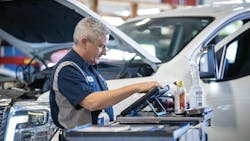I’m not an economist, but it doesn’t take a genius to understand that we are three years into high inflation, which is very unlikely to go negative, barring a total disaster worldwide.
We also are roughly four months away from 2025 and regardless of who wins the presidential election, inflation isn’t going to pop like a balloon. Interest rates will tick down a quarter of a point here and a quarter of a point there. But wages won’t magically reduce. In fact, at most tire dealerships, wages are stagnant. As a tire dealer, you can’t control the economy. You can control how you manage your business, though.
Net profit is one thing and it’s a very important thing. Net profit specifically shows you how much your efforts are being rewarded. Put another way, it measures the success of fixing customers’ vehicles.
In our industry, most tire dealerships are below 5% net profit, which is essentially one worker’s comp claim away from bankruptcy. Ten percent net profit is a fair trade-off for the risk, difficulty and hassle of being in a grinding industry. Fifteen percent net profit allows for you to be transformative.
Why? Because at 15%, there is ample net profit to help your balance sheet sustain more expenses and costs, like taxes, accounts payable, payroll commitments and oh yeah, future expenses like renovations, capital upgrades and more.
If you are making a net profit that makes you smile, that’s fantastic. That’s quite an accomplishment in a very tough, competitive and ever-changing market. But net profit doesn’t guarantee you’ll have money to sustain the act of being in business.
Net profit shows how well you fix cars. Cash flow shows how well you manage money. You can make net profit for years while slowly going bankrupt. You can show a net profit loss and remain open for a few years. What you can’t do is run out of money. At a low net — say, 5% — you won’t find many banks willing to lend to you because their risk is too high.
If you make profit, but run out of cash, you also will have to borrow money at some point. Borrowing money is very expensive right now and not likely to dramatically change.
Several years ago, I wrote a column about acquiring various loans when interest rates were close to zero. I didn’t factor in the emergence of a once-in-a-lifetime pandemic. I was simply looking at normal business cycles. It was a good time to cement access to cash, even if you didn’t need it. Today, it’s a far better choice to generate that extra cash through your business.
No matter what happens electorally, tough financial times will continue. In order to get through that, you need to go above just looking at your net profit. Get your nerd hat on and talk to your accountant or join a 20 group.
If your showroom looks like a kid’s party clown was recently there or the color scheme is from the 1970s or '80s, it’s because you have no cash flow.
And yes, you’ll hear this again: raise your labor rates. We are still close to $100 less than all other trades, hourly. If you are below $170 an hour as a base labor rate, you are harming your business and hurting the industry in general.
If you have a local competitor that charges far below your posted labor rate, make the difference even more striking. Force customers to question how could one guy do what you do for so much less? Don’t make it a $20 difference. That looks enticing enough for most customers to give the other shop a chance. Create a huge difference. Make it a no-brainer.
You had the guts to hang your own shingle and push through the first few years of struggle. It’s now time to make your shop shine. Charge what the industry demands so you have cash to pay for large equipment, renovations and the inevitable pay raises — and to make a life for yourself and your family. You earned it twice over.
So call your accountant and ask how you can make your balance sheet better, so you’re more prepared for the future. Bank the profit as much as you can and stay out of bad, short-term debt. I’ll get you started. Your asset-to-liabilities ratio should be one-to-one. Your return on assets should be at least 10%. And you should turn your inventory at least 10 times a year.
Don’t wait until tomorrow. Get started today.
About the Author

Dennis McCarron
Dennis McCarron is a partner at Cardinal Brokers Inc., one of the leading brokers in the tire and automotive industry (www.cardinalbrokers.com.) To contact McCarron, email him at [email protected].
